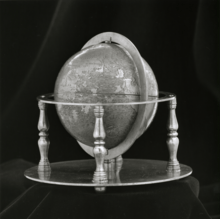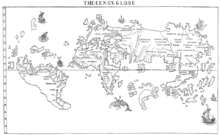Hunt–Lenox Globe
The Hunt–Lenox Globe or Lenox Globe, dating from 1504[1], is the second- or third-oldest known terrestrial globe, after the Erdapfel of 1492. It is housed by the Rare Book Division of the New York Public Library.

It is notable as one of only two known instances of a historical map actually using the phrase HC SVNT DRACONES (in Latin hic sunt dracones means "here are dragons".)
Description

The Lenox Globe is a hollow copper globe that measures 112 millimetres (4.4 in) in diameter and 345 millimetres (13.6 in) in circumference. It is two parts, joined at the equator and held together by a wire strung through holes at the poles.[3]
It bears a striking resemblance to the Globus Jagellonicus, dating from 1510.[4]
The phrase HIC SVNT DRACONES appears on the eastern coast of Asia.[5]
Background
The method of construction of this globe was unknown until the publication on the Ostrich Egg Globe dating from 1504 by S. Missinne in 2013.[6] It was purchased in Paris in 1855 by architect Richard Morris Hunt, who gave it to James Lenox, whose collection became part of the New York Public Library, where the globe still resides.
In his recollections, Henry Stevens recalled seeing the globe while dining with Hunt in 1870. Hunt was ambivalent about the globe, which he bought "for a song", and was allowing his children to toy with it. Stevens recognized its value and urged Hunt to store it in the Lenox Library, which he was designing at the time. Stevens also borrowed the globe to ascertain its age with the help of Julius Erasmus Hilgard, who worked for the Coast Survey—a predecessor to the US National Geodetic Survey.[7]
Publications

The earliest known article on the globe was written by B. F. de Costa for the Magazine of American History in September 1879.[8] Gabriel Gravier reprinted the article with additional comments in the Bulletin de la société normande de géographie later that year.[9]
However, neither article links hic sunt dracones to dragons. Da Costa writes:
In this region [China, called "East India" on the globe], near the equatorial line, is seen "Hc Svnt Dracones", or here are the Dagroians, described by Marco Polo as living in the Kingdom of "Dagroian". These people... feasted upon the dead and picked their bones (B.II. c.14, Ramusio's ed.)
In his translation of Da Costa's article, Gabriel Gravier adds that Marco Polo's Kingdom of Dagroian is in Java Minor, or Sumatra, well away from the spot indicated on the Lenox Globe.
The flat drawing of the globe which accompanied the early articles is reproduced as map 7 in Emerson D. Fite and Archibald Freeman's A Book of Old Maps Delineating American History (New York: Dover Reprints, 1969), and as figure 43 in A. E. Nordenskiöld's Facsimile-Atlas to the Early History of Cartography (New York: Dover Reprints, 1973).
A photograph of the globe itself can be found on page 81 of Ena L. Yonge's A Catalogue of Early Globes Made Prior to 1850 and Conserved in the United States (New York: American Geographical Society, 1968); however, the side with the inscription faces away from the camera.
References
- Missinne, Stefaan, The Da Vinci Globe, Cambridge Scholars Publishing, Newcastle-upon-Tyne, 2018, x + 282 p., 220 illustrations mostly in colour, 4 tables, 2 diagrams, 29 x 20.5 cm, soft cover, ISBN 978-1-5275-1134-7, op.cit. 46-60.
- Missinne, Stefaan, The Da Vinci Globe, op.cit. p. 74.
- Bulletin of the New York Public Library. New York: New York Public Library. January 1904. pp. 415.
- Missinne, Stefaan, The Da Vinci Globe, op.cit.pp 90-96.
- "The Hunt–Lenox Globe, Treasures of the New York Public Library". New York Public Library. Archived from the original on 22 January 2011. Retrieved 25 July 2010.
- Missinne, Stefaan (Fall 2013). "A Newly Discovered Early Sixteenth-Century Globe Engraved on an Ostrich Egg: The Earliest Surviving Globe Showing the New World".The Portolan, journal of the Washington Map Society (87): p. 8–24.
- Stevens, Henry (1886). Recollections of Mr. James Lenox of New York, & the Formation of His Library. Vermont: Henry Stevens & Son. pp. 140–143.
- De Costa, B.F. (September 1879). "The Lenox Globe". The Magazine of American History. New York: A. S. Barnes. 3 (9): 12.
- "Le Globe Lenox", Bulletin de la société normande de géographie (Oct–Dec. 1879), pp. 216–228.
External links
- The Hunt–Lenox Globe, Treasures of the New York Public Library